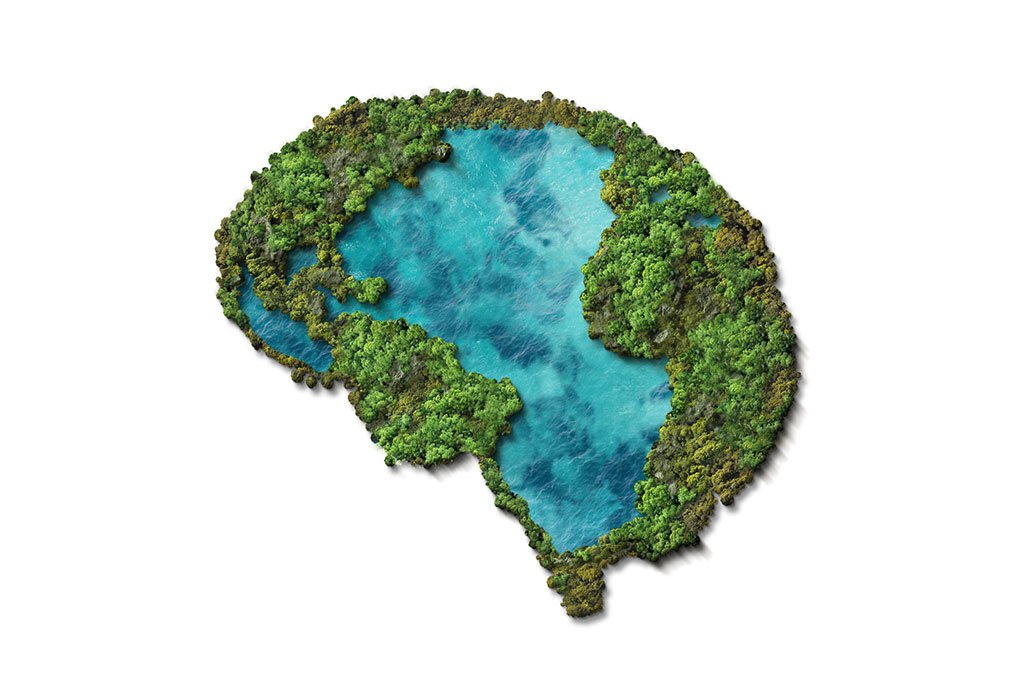
Studies of climate change impacts “have largely focused on physical health,” according to a policy brief issued in summer 2022 by the World Health Organization (WHO). “However,” the brief continued, “climate change also exacerbates many social and environmental risk factors for mental health and psychosocial problems, and can lead to emotional distress, the development of new mental health conditions and a worsening situation for people already living with these conditions.”
In other words, climate change is a mental health issue. And like the weather events seen around the globe, from severe storms to wildfires, the mental health effects of climate change are escalating.
NPQ reported in 2023 about the overlap between mental health and climate change, calling the two “the greatest crises of our times.” Both mental health and climate change are global crises, impacting billions around the world—and both strike people differently based on a host of factors, including socioeconomic status and location.
In the brief, the WHO provided specific recommendations for countries to incorporate mental health support into their climate crisis actions, but is the United States doing so? And as the climate crisis continues, whose mental health is most at risk?
Mental Health Impacts
Like a tornado leaving a path of destruction in its wake, any severe climate event creates a ripple effect that can disrupt a community for years, even generations.
Climate anxiety, also known as eco-anxiety, a term that has increased in popular usage, refers to severe dread about damage to the environment due to human-caused climate change. Eco-grief is another relatively new and popular term, which NPQ described as “the anguish and despair we feel when the places we live in and love deteriorate, along with these places’ ability to provide us with solace.”
Such feelings are understandable. The very real fallout of climate disasters can include the loss of family or loved ones and the loss of jobs. In the wake of emergencies like wildfires or floods, people may be forced to move, to leave their communities and support systems. They may lose their homes. According to the American Psychiatric Association (APA), this destabilization can lead to “cumulative community stress, increases in poverty, domestic violence, substance abuse, and forced migration.” Droughts and floods, in particular, as the APA noted, have been linked with depression, anxiety, suicide, and post-traumatic stress disorder (PTSD).
“They are in a situation beyond their ability to deal with,” Paul Logan, disaster response manager for the nonprofit Convoy of Hope, told AccuWeather about the survivors of the severe storms that hit the Southeast United States in late 2023. When tornadoes struck Tennessee—unusual for December and with little to no warning—multiple people died. Those left behind faced extensive rebuilding combined with trauma about the experience, uncertainty about the future, and feelings of stress, dread, and grief.
Mayor Joe Pitts of Clarksville, TN, told CNN after the tornado tore through his city, “There are no words. There’s not an adjective in the dictionary that would describe what we saw.”
Like a tornado leaving a path of destruction in its wake, any severe climate event creates a ripple effect that can disrupt a community for years, even generations. In its brief, the WHO traced the impact of prolonged droughts, which “significantly disrupt agricultural production and lead to loss of livelihood, leaving many communities in poverty, a factor clearly linked with many common mental disorders.” Water shortages and food scarcity caused by droughts can also lead to mental health conditions “associated with developmental delays, mental health issues, and neurological problems that can result from malnutrition.”
“Climate change may also lead to increased conflict, or aggravated conflict dynamics, particularly in regions dependent on agriculture,” according to the WHO. This, in turn, can lead to forced migration as families attempt to flee conflict. Those impacted the most by involuntary moves globally are children.
Sign up for our free newsletters
Subscribe to NPQ's newsletters to have our top stories delivered directly to your inbox.
By signing up, you agree to our privacy policy and terms of use, and to receive messages from NPQ and our partners.
The Most Vulnerable
The report found the “unequal burdens” of children are also deepened by climate change.Children are most at risk for the consequences of climate change in general—and environmental dangers to their mental health start even before birth. A report released in late 2023 by the American Psychological Association (APA) and ecoAmerica found that climate change can disrupt “the normal development of physiological systems, cognitive abilities and emotional skills.” And this derailment in children’s development may be irreversible.
The trauma and PTSD that may be caused by extreme weather events in the short term can contribute to lasting, long-term mental health issues without appropriate treatment, according to the report. Why are children most in jeopardy? Because they must rely on parents and other adult caregivers for safety and support, including mental health interventions.
The APA/ecoAmerica report, titled Mental Health and Our Changing Climate: Children and Youth Report 2023, also stated that “the perceived failure of governments to act on climate change is associated with distress among young people. Young people in the United States are more likely to be alarmed or concerned than their older counterparts.” Children and young adults may feel the pressure to try to prevent climate change, particularly as adults fail to do so, which can lead to feelings of helplessness and grief.
Programs…aimed at improving a community’s climate resilience must factor in mental health.
The report found the “unequal burdens” of children are also deepened by climate change. Children from communities of color “are more likely to be exposed to extreme weather and have fewer personal and economic resources for coping.” Other vulnerable communities include people with disabilities, women and girls, and outdoor workers, which can involve the children of agricultural workers.
Symbiotic Considerations
In the WHO brief, proposals for addressing mental health around the climate crisis included incorporating climate change into programs for mental health and psychosocial support, also known as MHPSS. Disaster risk reduction and preparedness programs—for example, those aimed at improving a community’s climate resilience—must factor in mental health as well. “Likewise,” the brief stated, “climate change should also be integrated into mental health strategies and plans, including MHPSS.”
The brief also called for adaptive interventions for climate change to factor in mental health. Such considerations can be symbiotic, benefitting both the environment and individuals’ psychological wellbeing. Public transportation, essential in case of a climate emergency, “can also be important for access to services and social interaction, which have positive effects on mental health,” according to the WHO. “Urban design that is environmentally friendly can provide green spaces for communities, with mental health benefits and stress reduction in different settings.”
These proposals align with the Mental Health and Our Changing Climate report, which suggested schools, already sites for shelter during and after disasters, could also provide accessible green space in nonemergency times and could model sustainability with updated buildings and structures.
“Curricula on climate change is important, coupled with hands-on opportunities to protect the environment,” according to the report, which also called for health professionals to include screening for climate change-related distress in children, and that after a weather disaster, “a conversation with a mental health provider may help children process emotions.”
All Necessary Steps Should Be Taken
Such proposals are relatively low-intensity, but are they being implemented? In 2023, the American Psychiatric Association held a committee on climate change and mental health, releasing a series of videos on how to talk with children about climate issues. The Disaster Distress Helpline offered confidential counseling and referrals to those impacted by the 2023 Southeast storms, as it has for all individuals experiencing disaster crises for a little over a decade. The theme for this year’s World Mental Health Day—an international day to raise awareness and reduce stigma around mental health—was “Mental Health is a Universal Human Right.”
This theme recalled the winning strategy of the young plaintiffs in the 2023 Montana climate justice court case, who successfully argued a clean environment was their human right. “For mental health to be recognized as a universal human right, there must be a transformation of societal attitudes and government policies,” Dr. Poonam Khetrapal Singh, WHO regional director for South-East Asia, wrote in a statement about World Mental Health Day. “All necessary steps should be taken to protect populations from the risks of mental health conditions that include overarching issues such as climate change.”
“This is a multiple-day event,” Clarksville’s mayor, Joe Pitts, said about the extensive restoration needed after the deadly storms in Tennessee. But climate change is a multiple-generation one, and the ramifications for mental health will continue to be experienced and need to be addressed far into the future.











